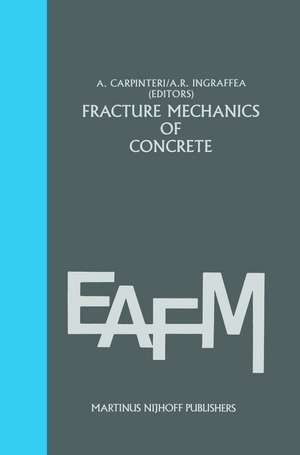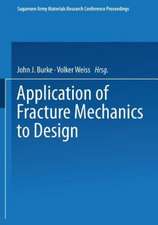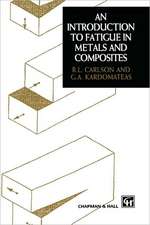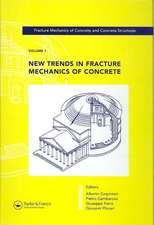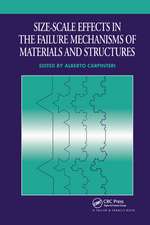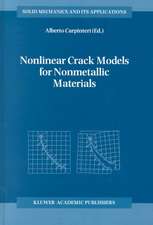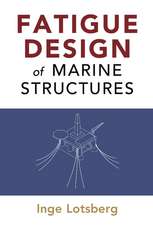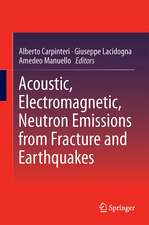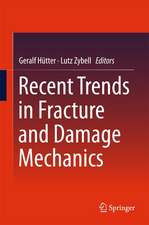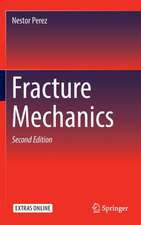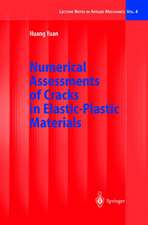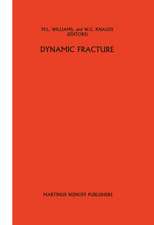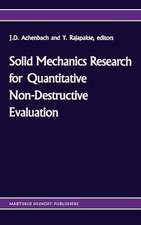Fracture mechanics of concrete: Material characterization and testing: Material Characterization and Testing: Engineering Applications of Fracture Mechanics, cartea 3
Editat de Alberto Carpinteri, Anthony R. Ingraffeaen Limba Engleză Hardback – 31 aug 1984
| Toate formatele și edițiile | Preț | Express |
|---|---|---|
| Paperback (1) | 383.71 lei 43-57 zile | |
| SPRINGER NETHERLANDS – 13 oct 2011 | 383.71 lei 43-57 zile | |
| Hardback (1) | 391.02 lei 43-57 zile | |
| SPRINGER NETHERLANDS – 31 aug 1984 | 391.02 lei 43-57 zile |
Preț: 391.02 lei
Nou
Puncte Express: 587
Preț estimativ în valută:
74.82€ • 78.33$ • 61.91£
74.82€ • 78.33$ • 61.91£
Carte tipărită la comandă
Livrare economică 07-21 aprilie
Preluare comenzi: 021 569.72.76
Specificații
ISBN-13: 9789024729593
ISBN-10: 9024729599
Pagini: 218
Ilustrații: XII, 202 p.
Dimensiuni: 155 x 235 x 17 mm
Greutate: 0.49 kg
Ediția:1984
Editura: SPRINGER NETHERLANDS
Colecția Springer
Seria Engineering Applications of Fracture Mechanics
Locul publicării:Dordrecht, Netherlands
ISBN-10: 9024729599
Pagini: 218
Ilustrații: XII, 202 p.
Dimensiuni: 155 x 235 x 17 mm
Greutate: 0.49 kg
Ediția:1984
Editura: SPRINGER NETHERLANDS
Colecția Springer
Seria Engineering Applications of Fracture Mechanics
Locul publicării:Dordrecht, Netherlands
Public țintă
ResearchCuprins
1. Mechanics of material damage in concrete.- 1.1 Introduction.- 1.2 Mechanical strength of concrete.- 1.3 Stress and fracture analysis.- 1.4 Damage analysis of concrete beam in bending: effects of softening and loading step.- 1.5 Scaling of specimen size.- 1.6 Long time behavior and failure of concrete.- 1.7 Local and global stationary values of strain energy density function.- 1.8 General discussion.- References.- 2. Evaluation of concrete fracture.- 2.1 Introduction.- 2.2 Mechanism of failure in concrete.- 2.3 Behaviour of concrete under loading related to damage.- 2.4 Mechanical modeling of concrete by means of fracture mechanics.- References.- 3. Fracture toughness testing of cement and concrete.- 3.1 Introduction.- 3.2 Physical phenomena involved in fracture.- 3.3 Rate of loading effects.- 3.4 Notch sensitivity.- 3.5 Historical review of the applications of fracture mechanics to cementitious materials.- 3.6 Fracture toughness parameters and techniques.- 3.7 Valid specimen size.- 3.8 Conclusions.- References.- 4. Dependence of concrete fracture toughness on specimen geometry and on composition.- 4.1 Introduction.- 4.2 Resistance curves.- 4.3 Theoretical model.- 4.4 Uniaxial tensile stress-displacement relationship.- 4.5 Experimental investigation.- 4.6 Comparison with experimental data.- 4.7 Effects of compositions.- References.- 5. Microcracking in concrete.- 5.1 Introduction.- 5.2 Microcracking of concrete.- 5.3 Methods of study of microcracking.- 5.4 Effects of microcracks on the properties of concrete.- 5.5 Cracking of higher-strength versus lower-strength concrete.- 5.6 Summary.- References.- 6. Interferometry in scattered coherent light applied to the analysis of cracking in concrete.- 6.1 Introduction.- 6.2 The suitability of interferometric methods in scattered coherent light in the analysis of concrete cracking.- 6.3 Significance and quality of fringes obtained with interferometry in scattered coherent light.- 6.4 Comparative summary.- 6.5 Application of interferometric methods in scattered coherent light to the analysis of concrete cracking.- 6.6 Conclusion.- References.- Author index.
Recenzii
`The present volume, which summarizes the recent results, is thus a very welcome addition to the literature. ...presents an outstanding exposition of the current research and the latest results. ...highly recommended to researchers, teachers, and graduate students in the field of fracture mechanics, and it should prove useful to concrete engineers as well.'
Journal of Applied Mechanics, 53:477 (1986)
Journal of Applied Mechanics, 53:477 (1986)
